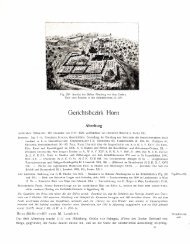- Page 7:
Rampton Court
- Page 15 and 16:
Rampton Court BY WILLIAM HOLDEN HUT
- Page 17 and 18:
PREFACE A word, with all apologies
- Page 19 and 20:
PREFACE VII the privileges which th
- Page 21 and 22:
INTRODUCTION " Iam never merry when
- Page 23 and 24:
CONTENTS CHAPTERI THE BUILDINGS AND
- Page 25 and 26:
CONTENTS XIII Queen Mary and Knelle
- Page 27 and 28:
CONTENTS XV PAGE characteristics of
- Page 29 and 30:
LIST OF ILLUSTRATIONS By HERBERT RA
- Page 31 and 32:
HAMPTON COURT CHAPTER I THE BUILDIN
- Page 35 and 36:
WOLSEY'S BUILDING 3 ing, it is scar
- Page 37:
-5** "a ■* I? ll. &
- Page 40 and 41:
6 HAMPTON COURT the bricks intermin
- Page 42:
8 HAMPTON COURT There is no better
- Page 46:
10 HAMPTON COURT his "Anecdotes of
- Page 50 and 51:
12 HAMPTON COURT Henry VIII., is as
- Page 52:
14 HAMPTON COURT The hall is entere
- Page 56:
16 HAMPTON COURT VII So, leaving th
- Page 60 and 61:
18 HAMPTON COURT If the court, when
- Page 62 and 63:
20 HAMPTON COURT interiors can hard
- Page 65 and 66:
GREAT GALLERIES 21 eminently suitab
- Page 67 and 68:
WREN'S PLANS 23 whom England has pr
- Page 69 and 70:
UNCOMPLETED WORK 25 shows how minut
- Page 71 and 72:
CHARACTERISTIC MERITS 27 Wren's wor
- Page 73 and 74:
EARLY HISTORY 29 King and Parliamen
- Page 75 and 76:
HISTORICAL MEMORIES 31 dwelling-pla
- Page 77 and 78:
WOLSEY'S GREATNESS 33 Cardinal-mini
- Page 79 and 80:
WOLSEY'S LIFE 35 which Wolsey built
- Page 83 and 84:
FESTIVITIES 37 satin paned, and cap
- Page 85 and 86:
FESTIVITIES 39 To whom the Cardinal
- Page 87 and 88:
ANNE BULLEN 41 passed they forth th
- Page 91 and 92:
FRENCH AMBASSADORS 43 Rooms already
- Page 93 and 94:
WOLSEY'S HOUSEHOLD 45 friends sent
- Page 95 and 96:
COSTLY BANQUETS 47 all others were,
- Page 99 and 100:
REVELRY 49 with ladies, some on hor
- Page 103 and 104:
WOLSEY'S DEATH 51 they were English
- Page 105 and 106:
HENRY'S AVARICE 53 there, they were
- Page 107 and 108:
QUEEN JANE 55 sorrow for the most f
- Page 109 and 110:
PRINCE EDWARD 57 The young Prince o
- Page 111 and 112:
TAYLOR'S SONNETS 59 skein of red si
- Page 113 and 114:
QUEEN ELIZABETH 61 Y Though Elizabe
- Page 117 and 118:
QUEENLY STATE 63 hair she wore a la
- Page 121 and 122:
THE PALACE IN 1598 65 " Hampton Cou
- Page 123 and 124:
ELIZABETH'S DEATH 67 The Palace whi
- Page 125 and 126:
JAMES I. 69 and say little of relig
- Page 127 and 128:
CHARLES I. 71 decisive step in the
- Page 129 and 130: HOSTILE AGITATIONS 73 the King in t
- Page 131 and 132: CROMWELL'S NEGOTIATIONS 75 servants
- Page 133 and 134: HIS LAST DAYS 77 have been satisfie
- Page 135 and 136: CROMWELL'S TENANCY 79 was his custo
- Page 139 and 140: COURT SCANDALS 81 when he doth not
- Page 141 and 142: PETER LELY 83 VIII At Hampton Court
- Page 143 and 144: LELY'S "BEAUTIES" 85 ladies." x If
- Page 145 and 146: LELY'S "BEAUTIES" 87 latter is the
- Page 147 and 148: WILLIAM OF ORANGE 89 does your Maje
- Page 149 and 150: CLAIMS TO GREATNESS 91 which he ach
- Page 151 and 152: AS DIPLOMATIST 93 certain unconscio
- Page 153 and 154: PRIVATE CHARACTER 95 that the issue
- Page 157 and 158: FAULTS AND VICES 97 withheld for ye
- Page 159 and 160: DE WITT MURDERS 99 of York's childr
- Page 161 and 162: GLENCOE MASSACRES 101 January 1692
- Page 163 and 164: AS KING 103 Parliament had declared
- Page 167 and 168: AT HAMPTON COURT 105 was not virtuo
- Page 169 and 170: KNELLER'S "BEAUTIES" 107 her husban
- Page 171 and 172: DEATH OF MARY 109 which the "Beauti
- Page 173 and 174: GEORGE I 111 Queen continued her ki
- Page 177 and 178: DEFOE ON THE PALACE 113 royal party
- Page 179: CHAPTER III THE PARKS AND GARDENS i
- Page 184 and 185: 118 HAMPTON COURT beautiful that it
- Page 186 and 187: 120 HAMPTON COURT divided, by the b
- Page 188: 122 HAMPTON COURT houses, the brave
- Page 192: 124 HAMPTON COURT graphia Rustica,"
- Page 196 and 197: 126 HAMPTON COURT Defoe states was
- Page 198: 128 HAMPTON COURT About the truth o
- Page 202 and 203: 130 HAMPTON COURT along the south w
- Page 204: 132 HAMPTON COURT already made. The
- Page 208 and 209: 134 HAMPTON COURT But why so far ex
- Page 210 and 211: 136 HAMPTON COURT circular design w
- Page 212: 138 HAMPTON COURT now been planted
- Page 216 and 217: 140 HAMPTON COURT made itself felt
- Page 218 and 219: 142 HAMPTON COURT the chapel from t
- Page 220: 144 HAMPTON COURT John Knox and Joh
- Page 224 and 225: 146 HAMPTON COURT the service while
- Page 226 and 227: 148 HAMPTON COURT diction, and one
- Page 228 and 229: 150 HAMPTON COURT James, shrewd as
- Page 230 and 231:
152 HAMPTON COURT too much — on t
- Page 232 and 233:
154 HAMPTON COURT Iwas forced at la
- Page 234 and 235:
156 HAMPTON COURT Correggio:Albrech
- Page 236 and 237:
158 HAMPTON COURT Eight rooms, said
- Page 238:
160 HAMPTON COURT Behind, on a rais
- Page 242 and 243:
162 HAMPTON COURT On this side of t
- Page 244 and 245:
164 HAMPTON COURT Below, in the cen
- Page 246 and 247:
166 HAMPTON COURT Regent of the Net
- Page 248 and 249:
168 HAMPTON COURT for the beauty an
- Page 250 and 251:
170 HAMPTON COURT Alexander the Gre
- Page 252 and 253:
172 HAMPTON COURT " exactly the kin
- Page 254 and 255:
174 HAMPTON COURT himself is small,
- Page 256:
176 HAMPTON COURT there are strikin
- Page 260 and 261:
178 HAMPTON COURT In No. 616, which
- Page 262 and 263:
180 HAMPTON COURT from the portrait
- Page 264 and 265:
182 HAMPTON COURT portrait of herse
- Page 266 and 267:
184 HAMPTON COURT Charles's reign,
- Page 268 and 269:
186 HAMPTON COURT it would be impos
- Page 270 and 271:
188 HAMPTON COURT the old world had
- Page 272 and 273:
190 HAMPTON COURT the later hand. M
- Page 274:
192 HAMPTON COURT VIII The " Triump
- Page 278 and 279:
194 HAMPTON COURT is difficult to r
- Page 280 and 281:
196 HAMPTON COURT the " Shepherd's
- Page 282 and 283:
198 HAMPTON COURT much of his impre
- Page 284 and 285:
200 HAMPTON COURT examples, as Prin
- Page 286 and 287:
202 HAMPTON COURT in Queen Anne's D
- Page 288 and 289:
204 HAMPTON COURT So we may bid far
- Page 290 and 291:
206 HAMPTON COURT Luxurious, there,
- Page 292:
208 HAMPTON COURT society indeed we
- Page 296 and 297:
210 HAMPTON COURT gentleman," in Wa
- Page 298:
212 HAMPTON COURT thebest-condition
- Page 302 and 303:
214 HAMPTON COURT Court preserves B
- Page 304 and 305:
216 HAMPTON COURT tocratic contempt
- Page 306 and 307:
218 HAMPTON COURT That is himself,
- Page 308 and 309:
220 HAMPTON COURT Queen Caroline, l
- Page 310 and 311:
222 HAMPTON COURT was exposed upon
- Page 312:
224 HAMPTON COURT in her heroism th
- Page 316 and 317:
226 HAMPTON COURT there in the eigh
- Page 318:
CHAPTER VII MEMORIES AND LEGENDS OF
- Page 322 and 323:
230 HAMPTON COURT as her picture sh
- Page 324 and 325:
232 HAMPTON COURT whose care so muc
- Page 326 and 327:
234 HAMPTON COURT tell us that he h
- Page 328 and 329:
236 HAMPTON COURT taught him, with
- Page 331 and 332:
Ambroise,Maistre, his " Francis I.
- Page 333 and 334:
George I., confusion and scandals i
- Page 335 and 336:
136; the birds and fish, 137; the g

















